Arranging Hypertufa Pots Into New Areas
If you are anything like me, I am always wanting to re-arrange things. And my hypertufa pots are no exception.
I need to find the best place to place hypertufa planters. That would be in an area that receives partial to full sunlight, depending on the specific plants you plan to grow in them. Most plants that are suitable for hypertufa planters prefer well-draining soil and moderate moisture levels.
I have lined the driveway nearest our garage with a lot of hypertufa pots this spring and they seem to be doing well. They will still dry out so I need to water them if it doesn’t rain.
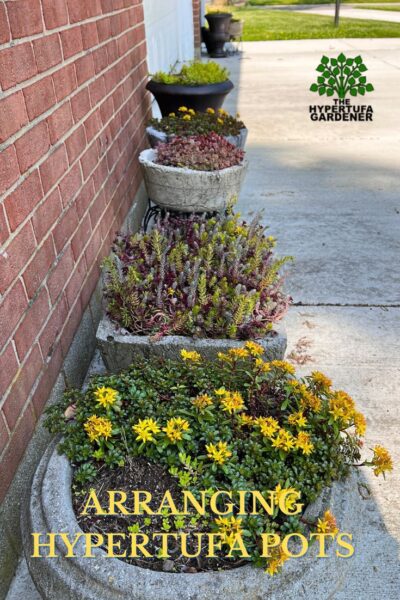
But it’s important to ensure that the planters are not placed in areas that are prone to waterlogging. In general, hypertufa planters are great for outdoor use. Depending on their size, they could get a little heavy and difficult to move once filled with soil and plants.
But indoor use is great too. I have a lot of houseplants indoors in hypertufa and it works very well.
Recommended Types of Plants for Hypertufa
There are many plants that can thrive in hypertufa planters. Here are some examples:
- Alpine plants: These are small plants that are typically found growing in rocky or mountainous areas. They are well-suited for hypertufa planters because they prefer well-draining soil and are tolerant of cooler temperatures. Examples include alpine forget-me-nots, saxifrages, and alpine primroses. I love alpine geranium or erodium.
- Succulents: These plants store water in their leaves and are well-suited for hypertufa planters because they prefer soil that is well-draining and not too wet. Examples include hens-and-chicks, sedums, and echeverias.
- Herbs: Many herbs are well-suited for hypertufa planters because they prefer well-draining soil and can tolerate dry conditions. Examples include thyme, oregano, and rosemary.
- Dwarf conifers: These small conifers are well-suited for larger hypertufa planters because they prefer well-draining soil and are tolerant of cooler temperatures. Examples include dwarf Alberta spruce, dwarf Japanese white pine, and dwarf Hinoki cypress.
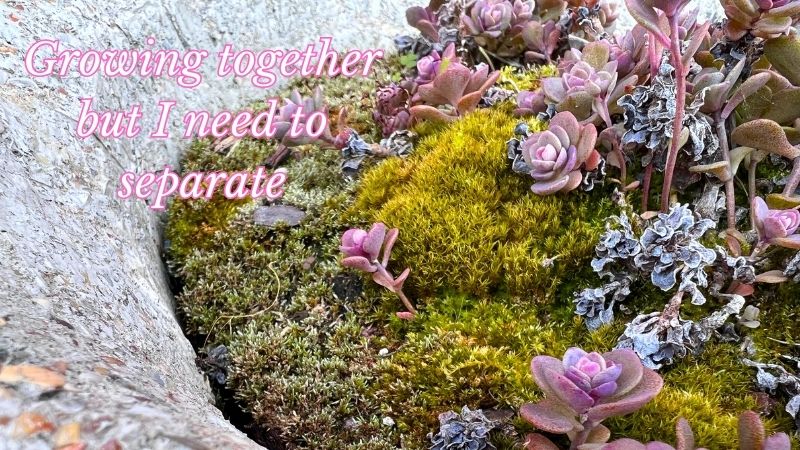
How About Mosses Growing in Hypertufa?
Mosses can also be a great option for growing in hypertufa planters. Mosses are non-flowering plants that prefer moist, shady conditions and can thrive in the porous walls and well-draining soil of hypertufa planters.
In fact, many gardeners use hypertufa planters specifically for growing mosses, as they can create a beautiful, textured look. I did that in my huge hypertufa planter in this post.
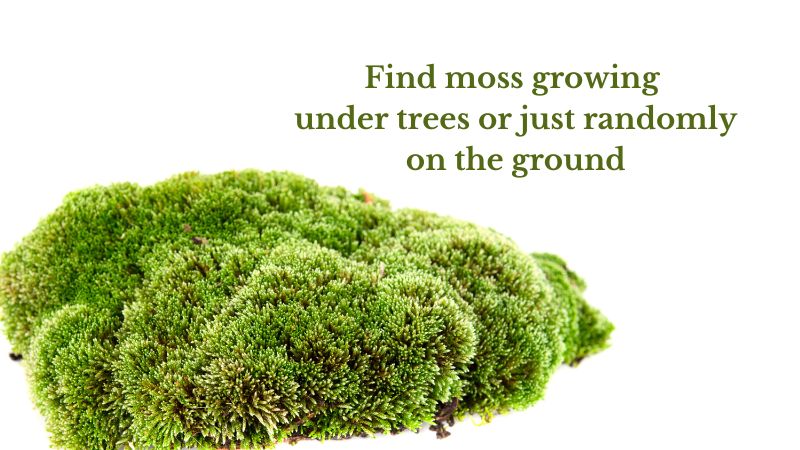
To grow mosses in hypertufa planters, you can mix peat moss, perlite, and sand in equal parts to create a well-draining growing medium. Using a wet soil mix, press it into the hypertufa planter, making sure to create a slightly uneven surface for the mosses to grow on.
You can then sprinkle moss spores onto the surface and mist the planter regularly until the moss becomes established. Or find moss from the ground in your yard. Around trees is a great place where I find it.
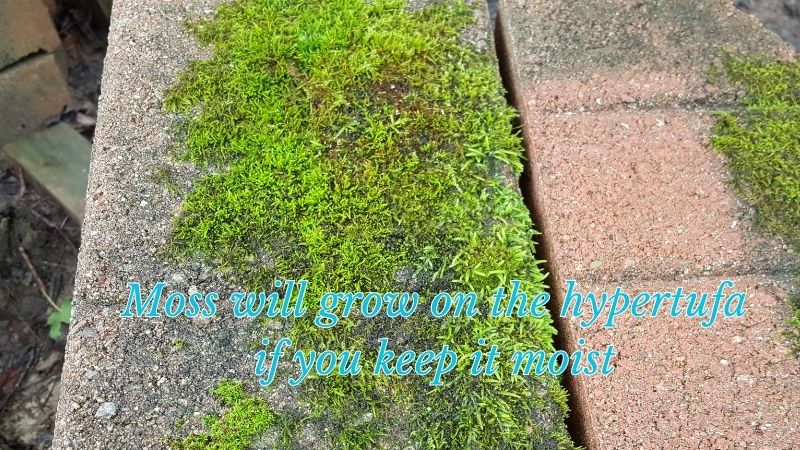
Mosses are low-maintenance and can add a beautiful, natural look to hypertufa planters. However, keep in mind that they may not tolerate full sunlight or dry conditions, so be sure to arrange your hypertufa planter in a shady area and water it regularly to keep the mosses healthy.
Do You Recommend A Bed of Gravel As Base for Hypertufa Collection?
Using a bed of gravel as a base for a hypertufa collection can be a good idea for several reasons. First, it can improve drainage and prevent water from accumulating at the bottom of the hypertufa planters, which can cause root rot and other issues.
Second, it can help stabilize the planters and prevent them from shifting or tipping over.
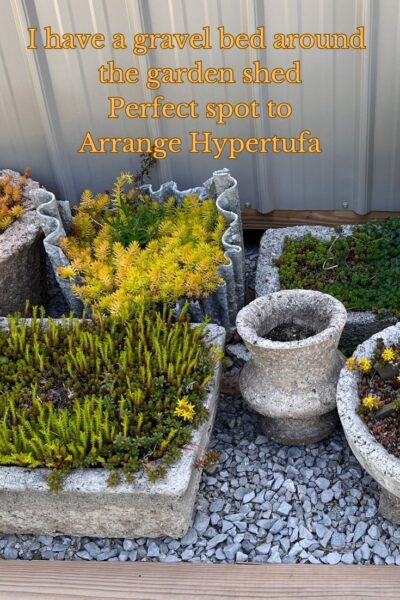
I use a portion of a gravel pad that was made for our garden shed as a location for some of my hypertufa pots. Currently it seems to work very well.
To create a bed of gravel as a base for your hypertufa collection, you can first level the ground where you plan to place the planters. Then, lay down a layer of cardboard ( I don’t like landscape fabric) to prevent weeds and other plants from growing up through the gravel.
Next, add a layer of gravel to the desired depth, typically 2-4 inches. Finally, place your hypertufa planters on top of the gravel, making sure they are level and stable. Be sure that there is no overhang nearby which could funnel water into the hypertufa pots.
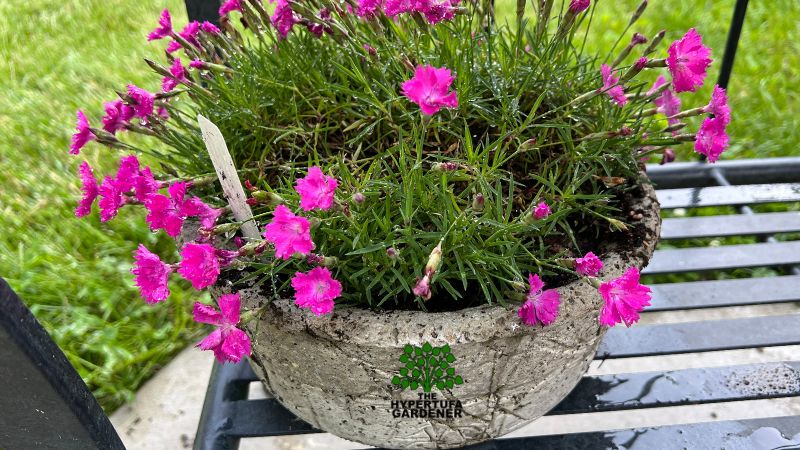
Keep in mind that using a gravel base is not strictly necessary for hypertufa planters, and may not be suitable for all situations. If you plan to move the planters frequently or if you are concerned about the excessive dryness of the collection, a gravel base may not be practical.
Keep in mind that if you plan to grow plants that prefer moist soil, such as mosses or ferns, a gravel base may not be best since this area may dry out too quickly. A gravel base is best for succulents and water-hoarding plants.

Changing Your Arrangement
If you are like me, I am always changing up my arrangements for my hypertufa gardens. That’s the fun of gardening in hypertufa pots: I can do a quick change every time I feel like it. (And can manage the task myself.)
Right now, I am liking an arrangement that I have along a sunny garage wall facing north. Suits me for now, but who knows what I will be changing it to next month!



